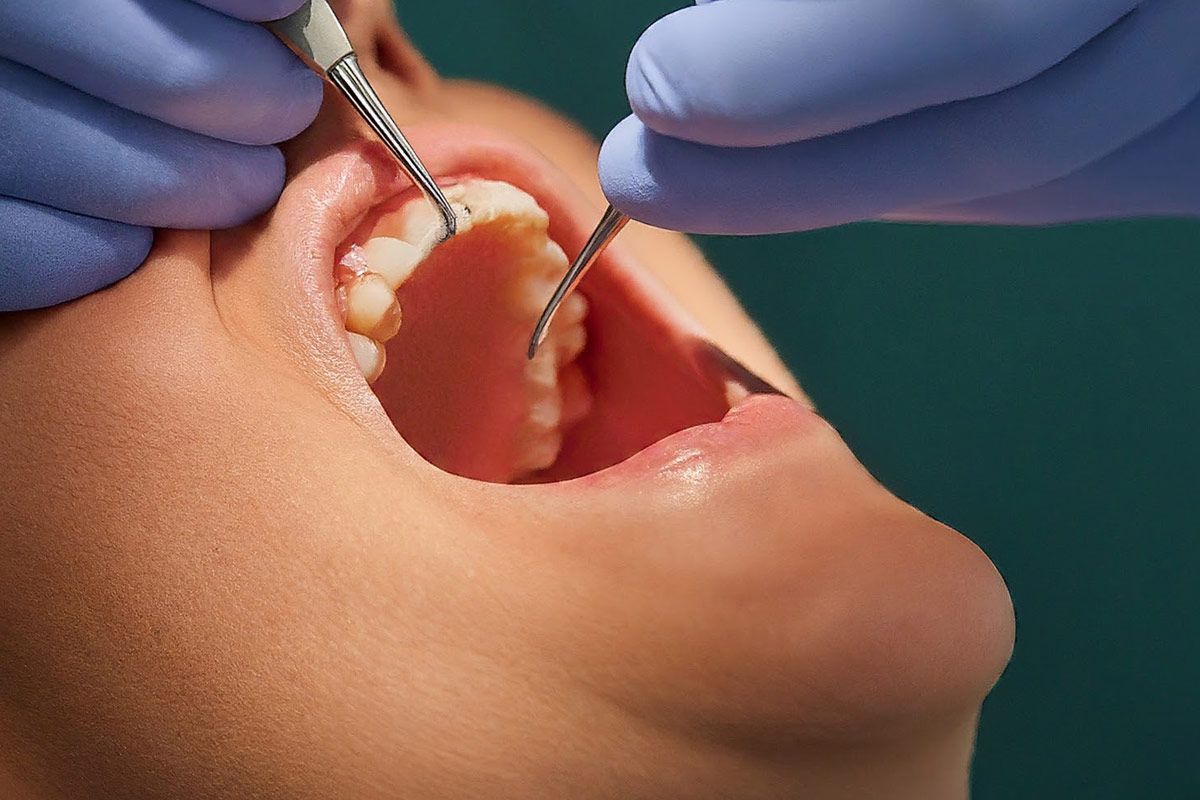The Operculectomy Procedure Explained

An operculectomy is a minor surgical procedure performed by a dentist or oral surgeon. It’s designed to remove the gingival operculum, a flap of excess gum tissue that can cover a partially erupted tooth.
This is most common with wisdom teeth and is done to prevent inflammation and improve oral hygiene.
What is a Gingival Operculum?
A gingival operculum is a flap of excess gum tissue that sometimes lingers over a tooth that hasn’t fully broken through the gumline.
Think of it like a little lid partially covering the tooth. This is most common with wisdom teeth due to their late eruption and limited space in the jaw, but it can potentially happen with any tooth that struggles to erupt correctly.
Read more: Gum flap over wisdom tooth.
What is an Operculectomy?
An operculectomy is a minor surgical procedure performed by a dentist or oral surgeon. It specifically addresses the issue of a gingival operculum (a flap of excess gum tissue covering a partially erupted tooth).
Here’s what the procedure involves:
- Removal of the operculum: The dentist removes the flap of gum tissue covering the partially erupted tooth.
- Improved hygiene: With the operculum gone, the area becomes much easier to clean, reducing the risk of plaque buildup and future infections.
- Preventing infection (pericoronitis): The operculectomy eliminates the pocket under the flap where bacteria thrive, significantly decreasing the chance of infection.
Your dentist may recommend an operculectomy if a partially erupted tooth, especially a wisdom tooth, is causing recurrent pain, swelling, or infections.
Why is an Operculectomy Necessary?
Here’s a breakdown of why an operculectomy might be necessary:
- Prevention and treatment of infection (pericoronitis): The biggest reason! The flap of tissue (operculum) creates a pocket that’s a breeding ground for bacteria. Removing it dramatically reduces infection risk and helps treat existing infections.
- Improved hygiene: The operculum makes the area very difficult to clean. Once it’s removed, keeping the tooth clean becomes easier, promoting better overall oral health.
- Pain relief: An infected operculum can be quite painful and swollen. An operculectomy eliminates the source of the infection, leading to pain relief.
- Preventing damage to other teeth: Sometimes, an upper tooth bites down on the operculum of a lower tooth, causing irritation. An operculectomy prevents this.
- Assisting with tooth eruption: In some cases, the operculum itself might be hindering the tooth’s full eruption. Once it’s removed, the tooth might erupt more easily.
What Types of Operculectomy Are There?
An operculum can be removed using various techniques, each with its own advantages and considerations. Here’s a detailed breakdown of the most common types:
1. Scalpel Excision (Traditional Method):
- Process: This time-tested method involves a dentist using a specialized surgical scalpel to meticulously cut and remove the dental operculum. The dentist has excellent control and direct visualization of the surgical site, allowing for precise manipulation of the tissue.
- Pros: Offers a well-established approach with a proven track record. The dentist has a high degree of control throughout the procedure, ensuring targeted removal of the operculum.
- Cons: Compared to laser techniques, scalpel excision can cause slightly more bleeding during the procedure. Some patients might find the use of a scalpel more anxiety-provoking.
- Suitability: Generally suitable for most operculectomy cases, particularly when the operculum is not overly large or complex. This method is a reliable and effective choice for many patients.
2. Electrosurgery:
- Process: This technique employs an electric current to simultaneously cut and cauterize the tissue. The current allows for precise cutting while minimizing bleeding by sealing blood vessels as they are cut. This can offer improved visibility during the procedure due to reduced bleeding.
- Pros: Reduces bleeding compared to a scalpel, offering better visibility during the procedure. This can be particularly beneficial for patients taking blood-thinning medications or those with concerns about excessive bleeding.
- Cons: Requires specialized equipment and carries a slightly higher risk of tissue damage if not used with precision. It’s crucial for the dentist to have a high level of expertise in using electrosurgical tools.
- Suitability: Ideal for cases where minimizing bleeding is a priority, like patients taking blood-thinning medications or those with a history of excessive bleeding.
3. Laser Surgery:
- Process: Utilizes a laser, often a carbon dioxide (CO2) laser, to vaporize and remove the excess gum tissue. Lasers offer a highly precise and controlled cutting method. The laser beam vaporizes the tissue, minimizing bleeding and potentially reducing post-operative discomfort.
- Pros: Minimizes bleeding compared to other techniques, potentially reduces post-operative discomfort, and may promote faster healing due to less tissue trauma. The precision of the laser can be advantageous for complex operculum cases.
- Cons: Requires specialized equipment and may be more expensive than other options. While generally safe, there are some rare potential laser-related side effects to consider during consultation with your dentist.
- Suitability: A good choice for patients concerned about minimal bleeding and faster healing. May be particularly suitable for complex operculum cases due to the high level of precision offered by lasers.
4. Radiosurgery:
- Process: A less common technique that uses high-frequency radio waves to cut and remove the gum tissue. Similar to electrosurgery, radiosurgery cauterizes blood vessels as it cuts, minimizing bleeding.
- Pros: Offers precise cutting and minimal bleeding. This can be beneficial for specific situations where bleeding control is crucial.
- Cons: Requires specialized equipment and is not as widely available as other techniques. Due to its less common use, there might be fewer dentists experienced with this specific approach.
- Suitability: May be considered for specific cases where other methods are not suitable, or when a dentist has particular expertise in radiosurgery.
Choosing the Right Technique:
Scalpel or laser, your dentist will select the best operculectomy technique for your specific situation after a thorough examination and discussion of your medical history. Factors considered include:
- Size and location of the operculum: Larger or more complex operculums might benefit from the precision of a laser.
- Bleeding concerns: Electrosurgery or laser might be preferred if minimizing bleeding is crucial, such as for patients taking blood-thinning medications.
- Your individual needs and preferences: Discuss your concerns and comfort level with pain or discomfort. Some patients might have a preference for one technique over another based on their individual anxieties or risk factors.
Remember, sometimes a combination of techniques might be used for optimal results.
The Operculectomy Procedure: Step by Step
Here’s a step-by-step breakdown of the operculectomy procedure. While the general flow is outlined below, specific details might vary slightly depending on the technique used (scalpel, laser, etc.) and your individual case.
Before the Procedure
Prior to surgery, your dentist or oral surgeon will explain the procedure, discuss any concerns, review your medical history, and ensure an operculectomy is the right option for you. Based on this initial diagnosis, X-rays will be needed.
X-rays provide detailed images of the tooth, roots, and surrounding bone, helping plan the procedure effectively.
You might be asked to fast before the procedure or make adjustments to medications as advised by your dental professional.
The Operculectomy Procedure
- Anesthesia: The area around the affected tooth is thoroughly numbed using a local anesthetic injection. You should not feel any pain during the procedure.
- Incision: Depending on the size and thickness of the operculum, using a scalpel or laser, the dentist might make a small incision to access the excess gum tissue fully.
- Removal of the Operculum: Using either a scalpel, laser, or other specialized tools, the dentist or surgeon carefully removes the excess gum tissue. Lasers offer a high level of precision and often minimize bleeding.
- Cleaning: The site is meticulously cleaned to remove debris and ensure bacteria are thoroughly cleared out.
- Sutures (optional): If the incision was large or bleeding needs to be controlled, the dentist might place a few sutures (stitches) to aid healing.
- Instructions: You’ll receive detailed post-operative instructions on pain management, dietary advice, oral hygiene practices, and follow-up appointments.
After the Procedure
- Discomfort: Some swelling, tenderness, and slight bleeding for a few days are normal. Over-the-counter pain medication is usually sufficient, but your dentist might prescribe something stronger if needed.
- Soft Diet: Stick to soft, cool foods for the first few days to avoid irritating the site. Gradually reintroduce harder foods as healing progresses.
- Oral Hygiene: Warm salt water rinses several times a day help keep the area clean and promote healing. Your dentist will specify when you can safely resume brushing and flossing near the surgical site.
- Follow-Up: Your dentist might schedule a follow-up appointment a week or so later to check healing progress, remove sutures if needed, and address any questions.
Operculectomy vs. Extraction
Operculectomy and extraction both address issues with partially erupted teeth, but in fundamentally different ways:
- Operculectomy: Removes the excess gum flap (operculum), preserving the tooth and reducing infection risk.
- Extraction: Removes the entire tooth, often used when the tooth is severely damaged, impacted, or creating orthodontic problems.
Your dentist will recommend the best option based on your specific tooth condition, overall health, and long-term oral health goals.
Read more: Operculectomy Vs Extraction
Operculectomy Risks and Potential Complications
While generally safe and effective, an operculectomy, like any surgical procedure, carries some potential risks and complications. Here’s what you need to know:
Common Risks & Complications
- Bleeding: Some bleeding during and after the procedure is normal. However, excessive or prolonged bleeding may require additional intervention by your dentist.
- Infection: While an operculectomy aims to reduce infection risk, an infection at the surgical site is possible, especially if post-care instructions aren’t followed. Signs include increasing pain, swelling, fever, or a bad taste in your mouth.
- Pain & Discomfort: Temporary pain, tenderness, and swelling are common for a few days following the procedure. Over-the-counter pain medication is usually sufficient.
Less Frequent Complications
- Nerve Damage: Nerves near the surgical site can sometimes be temporarily or, in rare cases, permanently affected. This might cause numbness, tingling, or altered sensation.
- Damage to Adjacent Teeth: While uncommon, there’s a slight risk of accidental damage to surrounding teeth during the procedure.
- Recurrence of the Operculum: In some cases, the gum tissue may partially grow back, although this is less likely than the initial infection risk.
How to Minimize Risks
- Choose an Experienced Dentist: Opt for a dentist or oral surgeon who has expertise in performing operculectomies. This significantly reduces the likelihood of complications.
- Follow Post-Operative Instructions: Careful adherence to your dentist’s instructions on wound care, pain management, and oral hygiene are critical for reducing infection risk and promoting proper healing.
- Communicate with Your Dentist: Report any unusual symptoms such as excessive bleeding, increasing pain, or fever to your dentist promptly.
FAQ on the Operculectomy Procedure
Can I perform an operculectomy at home?
Absolutely not! An operculectomy requires specialized training and sterile equipment. Attempting it at home carries high risks of infection, severe bleeding, accidental tooth damage, and even nerve injury. Please see your dentist. Read more: Operculectomy At Home
Are there alternatives to operculectomy?
Sometimes, yes, there are alternatives to an operculectomy, but their suitability depends heavily on your specific situation. Here’s what your dentist might consider:
- Monitoring: If the tooth is erupting well and causing minimal issues, your dentist might simply monitor the situation with regular checkups.
- Orthodontics: In some cases of mild crowding, orthodontics (braces or clear aligners) might create enough space for a partially erupted tooth to come in fully, avoiding the need for surgery.
- Coronectomy: If the roots of the tooth are near important nerves, a coronectomy might be an option. This involves removing the crown (top) of the tooth while leaving the roots in place, reducing the risk of nerve damage.
Can an operculum heal on its own?
While the operculum itself may disappear in some cases, it’s best to consult with a dentist for evaluation. They can assess the situation and recommend the best course of action to ensure your long-term oral health.
How long does the operculectomy procedure take?
An operculectomy is usually a quick, minor surgical procedure taking about 20-30 minutes on average. The exact time it takes can vary depending on the complexity of the operculum, the surgical technique used, the number of teeth involved, and how quickly the local anesthetic takes effect.
During your consultation, your dentist can give you a more personalized estimate for the length of your specific procedure.
Fact Checked
Our dedicated team rigorously evaluates every article and guide to ensure the information is factual, up-to-date, and free of bias.
Updated Regularly
We update our articles and reviews regularly to ensure you have access to the latest data in the dental industry.
The content on Dental3DU’s blog is intended for educational purposes only. This information should not be relied upon as professional medical counsel. Be sure to always consult with your dentist about the dangers and benefits of any medication, treatment or procedure.







